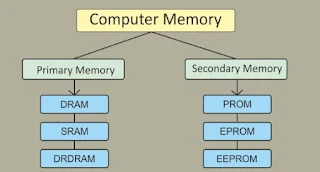What is a computer memory. Describe its units and discuss various types of memories?
 |
| Computer Memory |
Computer memory, often referred to simply as
"memory," is a fundamental component of a computer system that stores
and holds data, instructions, and information for processing. It plays a
critical role in the overall functioning of a computer, as it allows the
computer's central processing unit (CPU) to access and manipulate data quickly.
There are several types of computer memory, each serving
different purposes and having varying characteristics:
1. Random Access Memory
(RAM): RAM is the primary memory used by a computer when it is running
applications and performing tasks. It is volatile memory, meaning that its
contents are lost when the computer is powered off. RAM allows the CPU to
quickly access data and instructions that are currently in use, which
significantly speeds up the computer's performance compared to relying solely
on non-volatile storage like hard drives.
2. Read-Only Memory
(ROM): ROM is another type of memory, but unlike RAM, it is
non-volatile, meaning its contents remain even when the power is turned off.
ROM contains essential instructions and data that are necessary for booting up
the computer and starting the initial processes. It also typically stores
firmware and low-level system software that cannot be altered by the user.
3. Cache Memory: Cache
memory is a small, ultra-fast type of memory that sits between the CPU and RAM.
It stores frequently accessed data and instructions, allowing the CPU to
quickly retrieve them without having to fetch them from the slower RAM. This
caching process improves the overall performance of the computer.
4. Virtual Memory: Virtual
memory is a technique that allows the operating system to use a portion of the
hard drive as an extension of RAM. When the RAM becomes full, the operating
system moves less-used data from RAM to the hard drive, freeing up space for
more critical processes. Though virtual memory is slower than physical RAM, it
prevents the computer from crashing due to lack of available memory.
5. Flash Memory: Flash
memory is a type of non-volatile memory used in solid-state drives (SSDs),
memory cards, USB drives, and other storage devices. It retains data even when
there is no power supply. SSDs, in particular, have become popular as a faster
and more reliable replacement for traditional mechanical hard drives.
Overall, computer memory is a vital aspect of modern
computing, influencing system performance, responsiveness, and the overall user
experience. The balance between different types of memory and their respective
capacities is carefully designed to optimize a computer's functionality and
efficiency.
Computer memory is measured in bytes, where each byte consists of 8 bits. The most common units used to represent memory sizes are:
1.
Kilobyte (KB):
Approximately 1,000 bytes or 2^10 (1024) bytes.
2.
Megabyte (MB):
Approximately 1 million bytes or 2^20 (1,048,576) bytes.
3.
Gigabyte (GB):
Approximately 1 billion bytes or 2^30 (1,073,741,824) bytes.
4.
Terabyte (TB):
Approximately 1 trillion bytes or 2^40 (1,099,511,627,776) bytes.
5.
Petabyte (PB):
Approximately 1 quadrillion bytes or 2^50 (1,125,899,906,842,624) bytes.
6.
Exabyte (EB):
Approximately 1 quintillion bytes or 2^60 (1,152,921,504,606,846,976) bytes.
7.
Zettabyte (ZB):
Approximately 1 sextillion bytes or 2^70 (1,180,591,620,717,411,303,424) bytes.
8.
Yottabyte (YB):
Approximately 1 septillion bytes or 2^80 (1,208,925,819,614,629,174,706,176)
bytes.
Now, let's discuss various
types of computer memory:
1. Random
Access Memory (RAM): As mentioned earlier, RAM is the primary memory used
by the computer's CPU to store data and instructions that are currently in use.
It is volatile and faster than other forms of memory. RAM is typically made of
dynamic random-access memory (DRAM) chips.
2. Read-Only
Memory (ROM): ROM is a non-volatile memory that stores essential
system instructions and data that do not change. It is used for booting up the
computer and contains firmware and low-level software. ROM comes in various
forms, such as PROM (Programmable ROM), EPROM (Erasable PROM), and EEPROM
(Electrically Erasable PROM).
3. Cache
Memory: Cache memory comes in different levels, such as L1,
L2, and L3 cache. L1 cache is the fastest and is built directly into the CPU.
It stores frequently accessed data and instructions to reduce the time needed
to fetch information from RAM.
4. Virtual
Memory: Virtual memory is not a physical memory type but
rather a technique that uses a portion of the hard drive as an extension of
RAM. It allows the operating system to handle more significant amounts of data
and programs than the physical RAM can accommodate.
5. Flash
Memory: Flash memory is a type of non-volatile memory made of
floating-gate transistors. It is widely used in devices like SSDs, USB drives,
memory cards, and smartphones. Flash memory has no moving parts, making it more
durable and faster than traditional mechanical hard drives.
6. Hard
Disk Drive (HDD): While not a form of RAM, the HDD is a critical
storage medium for computers. It uses magnetic storage to read and write data
on spinning disks. Unlike RAM, it is non-volatile and retains data even when
the power is turned off.
7. Registers: Registers
are the fastest and smallest units of memory directly integrated within the
CPU. They hold data that the CPU is currently processing, and they facilitate
rapid access for arithmetic and logic operations.
Each type of memory serves
a specific purpose, and they work together in a hierarchy to provide efficient
and effective data storage and retrieval for modern computer systems. The
balance between different memory types helps ensure that data is available when
needed, whether for immediate processing (RAM and Cache) or long-term storage
(ROM, Flash Memory, and HDD).
